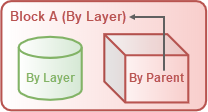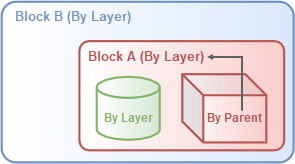![]()
Edit
Blocks >
Create Block Definition
| Toolbar | Menu | Shortcut |
|---|---|---|
|
|
Edit Blocks > Create Block Definition |
|
The Block command defines a block object from the selected objects and replaces the selected objects with an instance of the block.
Block Definition Properties
The name of the block definition.
See: Naming conventions in Rhino
Optional descriptive information.
Adds hyperlink information to a block definition. This information can be retrieved with the Hyperlink command.
A description of the URL.
A web address. Click the address to open the page in the default browser.
The properties of the geometry (curves, surfaces, etc.) that are contained in the block instance are controlled either by the layer properties or object properties of the geometry itself. Block instances that you insert to the model insert onto the current layer and can be moved to any other layer. There is no relationship between the block instance's layer and the geometry contained in the block. For example, the block geometry does not change to match the layer color onto which the block instance is inserted.
When the block contains objects on a specific layer, turning that layer off will turn off only the objects on that layer. However, if the layer the block instance is inserted on is turned off, all of the objects will disappear.
When you lock a layer, only the layer that contains the insertion point of the block instance is locked. If a block has objects that are on the locked layer, but the block instance insertion point is not on that layer, the object itself is not locked because the controlling factor is the layer of the block insertion point.
Grouped objects will not maintain their grouped status inside a block.
This option is only useful for objects in blocks. Think of a block instance as a container that contains objects (block members). A block instance is the parent of its block members. A block instance has its own properties. If By Parent is selected in the properties of a block member, the properties will be controlled by the block instance.
In this example, Block A contains a cylinder and a box. The Display Color of the box is By Parent and is controlled by its parent (Block A). The box will display Block A's layer color because the display color of Block A is By Layer. The cylinder will always display its own layer color and will not be changed by Block A.

Now Block A is nested in Block B. The box still displays Block A's layer color because By Parent only works with the direct parent.

If the Display Color of Block A is changed to By Parent, the display color of the box will be indirectly controlled by its grandparent (Block B).

By Parent can be selected for Display Color, Linetype, Print Color and Print Width in object properties. For the Render material, select Use Object Parent. Render materials are only visible in Rendered and Raytraced display modes by default.
| Toolbar | Menu | Panel Gear Menu |
|---|---|---|
|
|
Edit Blocks > Block Manager Window Floating Panels > |
Blocks |
The BlockManager command manages the block definitions in the model.
Blocks Dialog Box
Displays a list of block definitions in the model.
See: Naming conventions in Rhino
| Preview image right-click menu | |
|---|---|
|
Wireframe |
Sets the view to Wireframe display mode. |
|
Shaded |
Sets the view to Shaded display mode. |
|
Rendered |
Sets the view to Rendered display mode. |
|
Top |
Sets the view to World Top. |
|
Bottom |
Sets the view to World Bottom. |
|
Left |
Sets the view to World Left. |
|
Right |
Sets the view to World Right. |
|
Back |
Sets the view to World Back. |
|
Perspective |
Sets the view to World Perspective. |
Displays the status of block instances linked to external files.
The block definition and link file match.
The linked file is older than the block definition.
The linked file is newer than the block definition.
The linked file and the block definition do not match.
The block definition was not created by importing a file.
The file that was used to create a linked block definition cannot be found.
The missing block location is marked with a text dot object listing the missing block name.
For a description of the process Rhino uses to locate files used by worksessions and linked instance definitions, see Rhino Wiki: File finding.
Right-click on the block definition in the list:
Counts the number of instances of the block in the model. Nested instances are included in the count.
Lists block definitions that contain the selected block as a nested block.
Displays the text information of the block definition.
The name of the file that was imported to create the block definition.
For a file inserted as block instance.
 Embed
EmbedInsert geometry into the current file. This will not update if the external file changes.
 Link and embed
Link and embedInsert geometry into the current file and maintain a link to the external file. Linked geometry can be updated when the external file changes. If the external file cannot be located, the geometry is still defined in the current file.
 Link
LinkMaintain only a link to the external file. Linked geometry is updated when the external file changes. If the external file cannot be located, the geometry will not appear in the current file.
Blocks are saved with both absolute and relative paths.
Defines how layer names are organized
 Active
ActiveMerges layers with the same names.
 Reference
ReferenceCreates a parent layer using the name of the linked file. Layers in the linked file appear as sub-layers under the parent layer.
Adds hyperlink information to a block definition. This information can be retrieved with the Hyperlink command.
Enter a web address.
A description of the URL.
Select objects in the viewport to create a new block definition.
Insert a supported model format as a block definition.
Reload the linked block definition when it has been changed.
Select a model to replace the content of the linked block definition.
Embed the linked block definition.
Select instances of the selected block definition in the viewport.
Save the embedded block definition as a new model file.
Display the block names beginning with * (asterisk character).
Update "Embedded and linked" blocks each time the model is opened.
Prompt before updating "Embedded and linked" blocks each time the model is opened.
When a file opens, the Block Definitions to Update dialog box prompts for action.
Never update "Embedded and linked" blocks and do not prompt.
Delete the selected block definition and all of its instances in the model.
Insert the selected block or an external model in the model space.
| Toolbar | Menu |
|---|---|
|
|
Edit Blocks > Edit Block in Place |
The BlockEdit command allows selecting a block instance to change the block geometry and update the block definition.
Click Apply to accept the editing.
To cancel, click the red button at the upper-left corner.
| Command-line options | |
|---|---|
|
PromptToEditLinkedBlocks |
Linked blocks are not stored in the Rhino file, but are a connection to an external model. To edit linked blocks, Rhino opens the external model in a separate instance of Rhino. The current editing session is paused until the external file is locked. YesPrompts to open a linked block. NoOpens the linked block without prompting. In the Edit Linked Block dialog box, checking the Don't ask this question again... box automatically sets the PromptToEditLinkedBlocks to No. |
Block Edit options
The Block Edit dialog box displays the block name and a list of any blocks nested in it.
Adds selected objects to the block definition. If the selected object is a block, this becomes a nested block and will display in the tree the next time the BlockEdit command is run.
The object added is copied to the block definition and the original object remains in the model.
Removes selected objects from the block definition.
When the block is updated, the removed objects are added to the model as separate individual objects.
Repositions the block insertion point.
When the block is updated, the block instance will shift so the new insertion point is placed at the block insertion location.
| Toolbar | Menu |
|---|---|
|
|
|
The ReplaceBlock command redefines selected block instances with a different block definition.
| Command-line options | |
|---|---|
|
SelectFromBlockDefinitionList |
Displays a list of block definitions in the model to select from. |
|
All |
Selects all instances of the current block definition including unselected, hidden, and locked instances. |
|
None |
Selects no additional instances. Only the selected instances will be changed. Or Select a block from the definition list. |
| Toolbar | Menu |
|---|---|
|
|
|
The CopyLinkedBlockDefinition copies a linked block with Reference style layers.
Work with blocks, groups, and worksessions
Rhino 6 for Mac © 2010-2020 Robert McNeel & Associates. 11-Nov-2020